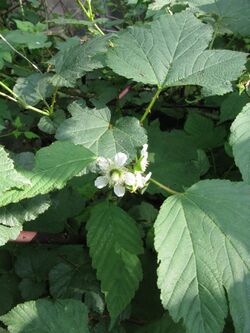Biology:Rubus crataegifolius
| Rubus crataegifolius | |
|---|---|

| |
| May 2009, Japan | |
| Scientific classification | |
| Kingdom: | Plantae |
| Clade: | Tracheophytes |
| Clade: | Angiosperms |
| Clade: | Eudicots |
| Clade: | Rosids |
| Order: | Rosales |
| Family: | Rosaceae |
| Genus: | Rubus |
| Subgenus: | R. subg. Idaeobatus |
| Species: | R. crataegifolius
|
| Binomial name | |
| Rubus crataegifolius Bunge
| |
Rubus crataegifolius, also called Korean raspberry,[1] is a species of raspberry native to East Asia.[2]
It is a shrub growing to 1–2 m (rarely 3 m) tall. The leaves are 5–12 cm long and 5–8 cm broad, palmately lobed with three or five lobes, and a serrated margin. The flowers are 1–1.5 cm diameter, with five white petals. The fruit is an aggregate fruit 1 cm diameter, made up of numerous drupelets. The species grows on forest margins and mountain slopes, in areas with moist and well-drained soil.
Its fruit is used for food and is sometimes cultivated; the cultivar 'Jingu Jengal' has been selected for its large fruit.[3] Root extracts have been found to contain substances with anti-inflammatory effects in mice.[4]
Notes
- ↑ English Names for Korean Native Plants. Pocheon: Korea National Arboretum. 2015. pp. 612. ISBN 978-89-97450-98-5. http://www.forest.go.kr/kna/special/download/English_Names_for_Korean_Native_Plants.pdf. Retrieved 22 December 2016.
- ↑ "Rubus crataegifolius Korean raspberry PFAF Plant Database". http://www.pfaf.org/user/Plant.aspx?LatinName=Rubus+crataegifolius.
- ↑ Plants for a Future :Rubus crataegifolius
- ↑ "Anti-inflammatory effects of alcoholic extract of roots of Rubus crataegifolius Bge. (PubMed abstract)". Zhongguo Zhong Yao Za Zhi 21 (11): 687–8. 1996. PMID 9812702.
External links
Wikidata ☰ Q907007 entry
 |


